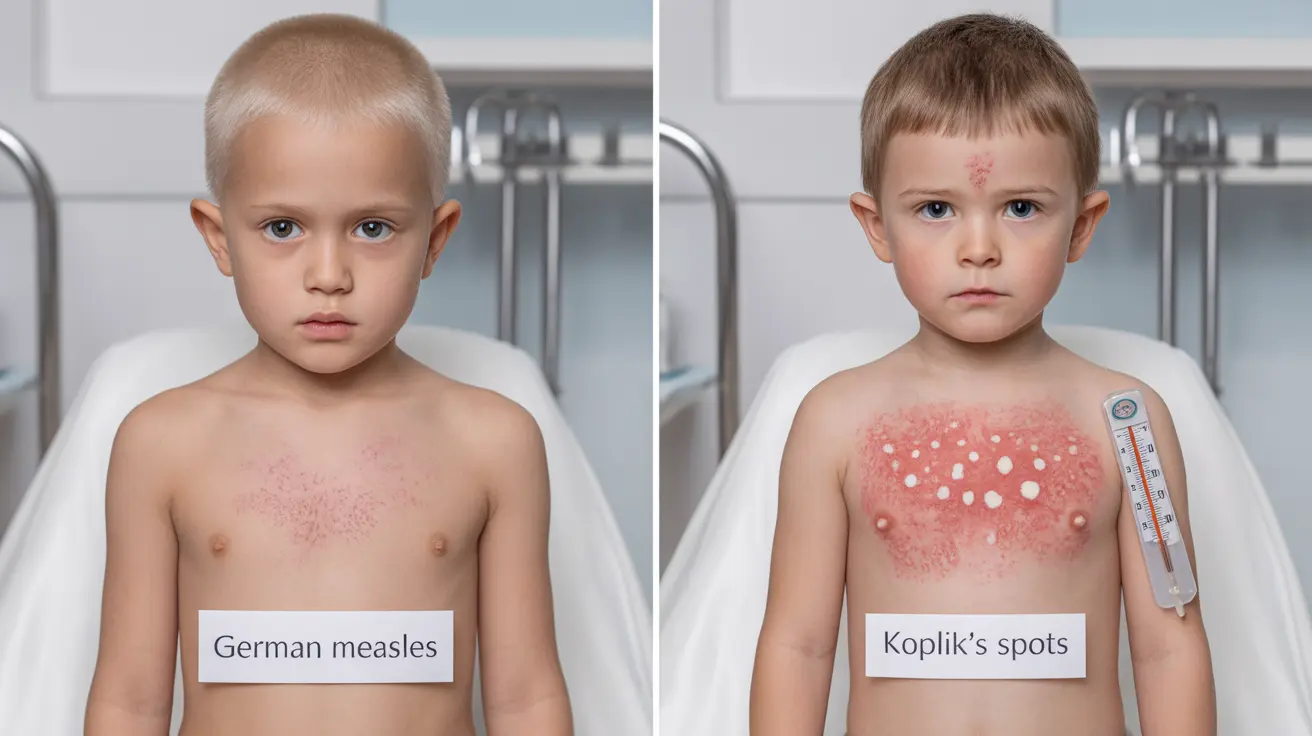While German measles (rubella) and measles (rubeola) may share similar names, they are distinct viral infections with different characteristics, symptoms, and potential complications. Understanding these differences is crucial for proper identification, treatment, and prevention of both diseases.
Both conditions are serious but preventable through vaccination. Let's explore their unique features, how to identify them, and why prevention is so important, especially for certain high-risk groups.
Key Characteristics and Symptoms
German Measles (Rubella)
German measles typically presents as a milder infection characterized by:
- Mild fever (usually under 102°F)
- Swollen lymph nodes behind the ears
- Pink or light red rash starting on the face
- Rash that spreads downward and typically fades within 3 days
- Joint pain, particularly in adults
- Mild cold-like symptoms
Measles (Rubeola)
Measles tends to be more severe, with symptoms including:
- High fever (often exceeding 104°F)
- Severe cold-like symptoms
- Distinctive white spots (Koplik's spots) inside the mouth
- Red, blotchy rash starting at the hairline
- Rash that spreads downward and can last 5-6 days
- Significant fatigue and weakness
Transmission and Contagion Period
Both diseases spread through respiratory droplets, but their contagious periods differ. German measles is contagious for about one week before and after the rash appears. Measles is highly contagious from four days before to four days after the rash emerges, with a 90% transmission rate among unvaccinated close contacts.
Special Risk Considerations
Pregnancy and German Measles
German measles poses a particular threat during pregnancy, especially in the first trimester. Infection can lead to congenital rubella syndrome (CRS), potentially causing:
- Hearing impairment
- Heart defects
- Vision problems
- Developmental delays
- Other birth defects
Measles Complications
Measles can lead to serious complications, particularly in:
- Young children under 5
- Adults over 20
- Pregnant women
- People with weakened immune systems
Common complications include ear infections, pneumonia, and in rare cases, encephalitis (brain inflammation).
Prevention and Protection
The MMR (Measles, Mumps, Rubella) vaccine effectively prevents both conditions. The CDC recommends two doses: the first at 12-15 months and the second at 4-6 years. The vaccine is approximately 97% effective at preventing both diseases when properly administered.
Frequently Asked Questions
What is the difference between German measles (rubella) and measles (rubeola) in terms of symptoms, severity, and risks?
German measles is generally milder, causing low-grade fever, mild rash, and swollen lymph nodes. Measles is more severe, with high fever, distinctive Koplik's spots, and a more intense rash. Measles typically poses more immediate health risks, except in pregnant women, where German measles can cause serious birth defects.
How do the rashes of German measles and measles look different, and where do they usually start on the body?
German measles produces a pink or light red rash starting on the face and spreading downward, typically lasting about 3 days. Measles causes a red, blotchy rash beginning at the hairline and spreading downward, lasting 5-6 days and often becoming joined together.
Why is German measles (rubella) especially dangerous for pregnant women, and what are the risks to the baby?
German measles during pregnancy, particularly in the first trimester, can cause congenital rubella syndrome (CRS). This can lead to serious birth defects including hearing loss, heart problems, cataracts, and developmental delays.
What are the most common complications of measles (rubeola), and who is most at risk for serious illness?
Common measles complications include ear infections, pneumonia, and rarely, encephalitis. Young children, adults over 20, pregnant women, and immunocompromised individuals face the highest risk of serious complications.
Can the MMR vaccine protect against both German measles and measles, and how effective is it at preventing these diseases?
Yes, the MMR vaccine protects against both German measles and measles. With two properly timed doses, it is approximately 97% effective at preventing both diseases. The vaccine is a crucial tool in preventing outbreaks and protecting vulnerable populations.




